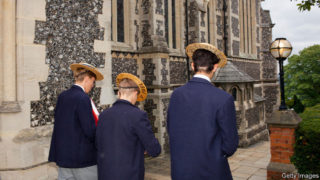Some will probably be forced to close. Those that remain must adapt
IN SEPTEMBER, WHEN pupils return to Strathallan, an independent boarding school in Perthshire, Scotland, they will find the school a little different. Their temperatures will be taken each morning. A one-way system will steer them around the sprawling campus. Socially distanced lessons will be conducted on laptops, both to stop the passing of hand-held papers and to ensure that any pupils who have to be isolated can still take part.
As Mark Lauder, Strathallan’s headmaster, cheerfully explains these measures, he acknowledges that the school’s space and money make them possible. Most of the 560 pupils—aged from nine to 18—have their own bedroom; sport and other activities can take place in the 153-acre grounds; most of the staff live on the site. Significant investment has been made to upgrade the Wi-Fi this summer, ensuring that there’s enough bandwidth to keep the pupils online. Although the school has taken a financial hit due to the coronavirus pandemic, Mr Lauder is confident it will stay afloat. But to do so it is likely to have to adapt further, and not all elite schools will manage that. “Before covid struck,” Mr Lauder notes, “we already knew the market was reshaping. This is a catalyst to that reshaping.”
In Britain, independent schools educate a rarefied 6.5% of the student population. Some report a flurry of interest from parents dissatisfied with remote state education during lockdown. In April the Sutton Trust, an education charity, determined that half of all primary school pupils and 64% of secondary school pupils were working for three hours a day or less. Those doing more were likely to be at private schools, two-thirds of which already had online platforms and which were much more rapidly able to pivot to virtual lessons. Mr Lauder says that Strathallan has taken on a “handful” of new students since the pandemic started, with more expected next term.
Even so, many of the country’s private schools may soon find themselves in trouble. In May TES, an education publication, reported concerns from within the sector that up to 30% of independent schools could “go bust” in the next couple of years. Lower fees and a fall in recruitment of foreign pupils may force closures and mergers. Many schools are already in a precarious financial position. Some have built expensive facilities to attract pupils. All face a 43% increase, implemented last September, in employers’ contributions to the Teachers’ Pension Scheme. Previously, some floundering British private schools have been bought as investments by businesses in Hong Kong and (especially) China. Worsening relations between China and Britain may make such rescues less likely.
Ensuring that Chinese children can still attend has become a priority for many boarding schools. In Britain, pupils from China and Hong Kong make up 43% of those with parents abroad—and 22% of the total—according to a census carried out by the Independent Schools Council. Hundreds of British schools have arranged special flights with a Chinese airline ahead of the new term, with some also providing dedicated quarantine facilities. Diplomatic tensions could eventually become a factor too. China is not averse to using its demand for education as a political lever, having banned university students from studying in Taiwan and warned them away from Australia. (Australia is also highly dependent on Chinese students, with 160,000 enrolled in universities and 12,000 in schools.) Although there have been reports that Chinese families shunned American boarding schools after Donald Trump referred to students as “spies”, British schools do not yet appear worried about Chinese pupils being held back for political reasons. (Indeed, there are signs that political upheaval in Hong Kong will fuel parents’ desire to send their offspring abroad.)
In America, many private schools have attracted attention by promising to open full-time in the autumn semester, whereas public schools in the same districts are planning to open only part-time or online until at least the new year. In part, this is because they have the resources: the New York Times reported that Punahou, a private school in Honolulu, had engaged an epidemiologist and installed thermal scanners to take pupils’ temperatures. Private schools (and charter schools, which are independent but receive state funding) also have less government oversight. Moreover, their staff are far less likely to be in unions, which are lobbying to keep their members out of classrooms for the time being. But American private schools are also reopening because they feel they have to, points out Douglas Harris, a senior fellow in the Brown Centre on Education Policy at Brookings, a think-tank. Offering fully in-person tuition is one way these schools can differentiate themselves from public schools and try to retain their students.
However, scale and diversification may be even better defences against the pandemic. Several elite schools turned themselves into international, multi-campus businesses years ago. In the past 20 years, English-language education has blossomed into a $55bn market, fertilised mainly by demand from China and the Middle East. Prestigious, mostly British, boarding schools have set up partner institutions in other countries. Harrow—the north London alma mater of Winston Churchill, where fees exceed £42,000 a year—opened its first international school in Bangkok in 1998. Last year it had 4,800 pupils in Thailand, Hong Kong and China, and it plans to open another five schools in China this year, despite the pandemic. Several other British boarding schools educate many more children abroad than they do at home. In the next decade Westminster School plans to have 20 times more students in China than in London.
Yet such institutions are still expensive to attend and the coronavirus may disrupt education further over the coming year. Schools are therefore experimenting with entirely new models: in September Harrow will launch a fully online sixth form (ie, for 16- to 18-year-olds) for English-speaking students “looking for a prestigious, high-quality British education that suits their lifestyle”. Harrow Online, a collaboration with Pearson, an education company, was already in the works before the pandemic. When the school opens its digital doors, it will take both British and international students. Several other schools, including Strathallan, are considering something similar, which would allow them to capture a new slice of the market: parents who want a British brand-name education, but can’t afford, or don’t want, to send their children to the bricks-and-mortar institutions.
This summer Eton College—the boarding school famous for having produced 20 British prime ministers—began offering free video courses to teenagers at state schools, via EtonX, its online platform. Eton’s headmaster has told Tatler, a high-society magazine, that “the right thing now is to share our wealth, resources and expertise”. Harrow Online too will go some way to opening up the most elite institutions to a wider pool of students (though, at £15,000 a year, it is hardly widely attainable). Yet if the leading private schools thrive while smaller ones fall away, private education will follow a post-pandemic pattern predicted for other industries. And the opportunities it affords may become even more stratified.
The Economist





